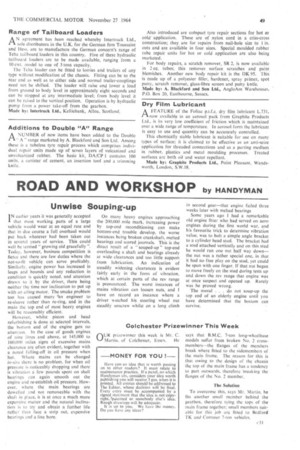ROAD AND WORKSHOP by HANDYMAN
Page 51

If you've noticed an error in this article please click here to report it so we can fix it.
Unwise Souping-up
I N earlier years it was generally accepted that most working parts of a large vehicle would wear at an equal rate and that in due course a full overhaul would put back whatever had been taken out in several years of service. This could well be termed "growing old gracefully ". Today, however, business competition is fierce and there are few duties where the not-so-fit vehicle can serve profitably. Similarly, engine power has increased in leaps and bounds and any reduction in condition is quickly noted, and attention drawn to it by the driver, there being neither the time nor inclination to put up with an ailing motor_ The smoke problem too has caused many aan engineer to re-sleeve rather than re-ring, and in the maul the top end of most heavy engines will be reasonably efficient.
However, whilst piston and head refurbishing is done at selected intervals, the bottom end of the engine gets no attention. In the case of goods engines of nine litres and above, at 145.000 to 160,000 miles signs of excessive mains clearance are often evident, together with a noted falling-off in oil pressure when hot. Where mains can be changed in-situ there is no problem, for when oil pressure is noticeably dropping and there is vibration a few pounds spent on shell bearings can again smooth out the engine and re-establish oil pressure. However, where the main bearings are douelled and not removeable with the shaft in place, it is at once a much more expensive matter and the natural inclination is to try and obtain a further life rather than face a strip out, expensive bearings and a line bore.
On many heavy engines approaching the 200,000 mile mark, increasing power by top-end reconditioning can make bottom-end trouble develop, the worse instances being broken crankshaft, melted bearings and scored journals. This is the direct result of a souped-up" top-end overloading a shaft and bearings already at wide. clearances and too little support from lubrication. An indication of steadily widening clearances is evident fairly early in the form of vibration, which at certain parts of the rev range is pronounced. The worst instances of mains vibration can loosen nuts, and I have on record an instance where a driver watched his steering wheel nut steadily unscrew whilst on a long climb in second gear—that engine failed three weeks later with melted bearings Some years ago I had a remarkable old engine fitter who had served on aero engines during the first world war, and his favourite trick to determine vibration value, was to bolt a simple angle bracket to a cylinder head stud. The bracket had a stud attached vertically and on this stud he would run one nut half way down— the nut was a rather special one, in that it had no free play on the stud, yet cOuld be spun with one linger. If that nut began to move freely on the stud during tests up and down the rev range that engine was at once suspect and opened up. Rarely was he proved wrong.
The moral . . . do not soup-up the top end of an elderly engine until you have determined that the bottom can survive.
















































































































